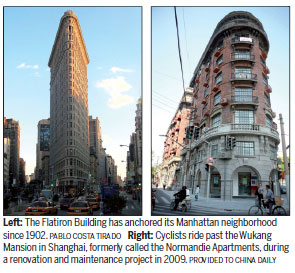Flatiron buildings offer degree of recognition in far-flung cities
(China Daily USA) Updated: 2017-02-02 13:35I've never been to Shanghai, but I know it has a building that looks like one of my favorites in New York.
The Wukang Mansion in Shanghai's French Concession district, built in 1924, has that wedge design that looks like, well, a flatiron.
That happens to be the name of its older and taller cousin in New York -the Flatiron Building, completed in 1902 - and of the fashionable neighborhood it straddles in Manhattan.
The Wukang checks in at eight stories high, while the Flatiron, at 22 stories, once was one of the tallest buildings in New York. While the Flatiron Building was named for its appliance shape, it also has plenty of iron itself - its frame is steel.
I asked Shanghai native Chen Weihua, China Daily deputy editor, his thoughts on the Wukang.
"This is a well-known building in Shanghai. Yes, it reminds people of the NYC sister building Flatiron. It is in the old French Concession area and along the Huaihai Road, a major street in Shanghai, like Broadway in NYC, so passers-by can see it very clearly. There are many Western-style buildings in that area.
"When back in Shanghai last April, I took a walk in the area with my mom and enjoyed the relaxed mood," Chen said. "In fact, the building is two or three blocks from our former China Daily Shanghai office, which was in the Hengshan Hotel.
"I love old buildings," he continued. "Shanghai is a city known as a showcase of architecture styles from around the world. Before 1949 and especially in the 1930s, it was the paradise of adventurers from around the world."
Designed by Laszlo Hudec, a famous Hungarian-Slovak architect, the Wukang Mansion has been home to some high-profile personalities.
Wang Renmin, a 1930s film actress known as the "Wildcat of Shanghai", once called the Wukang home, as did acclaimed Chinese actor and director Sun Daolin. Actress Shangguan Yunzhu reportedly jumped to her death off the building's seventh floor.
A century or so ago, New Yorkers were unsure what to think of the Flatiron Building. The New York Tribune called it "a stingy piece of pie ... the greatest inanimate troublemaker in New York", while the Municipal Art Society said that it was "unfit to be in the center of the city". The New York Times called it a "monstrosity".
H.G. Wells wrote in his 1906 book The Future in America: A Search After Realities: "I found myself agape, admiring a sky-scraper the prow of the Flat-iron Building, to be particular, ploughing up through the traffic of Broadway and Fifth Avenue in the afternoon light."
When the United States entered World War I, the government started a "Wake Up America!" campaign, and the United Cigar store in the Flatiron's "cowcatcher" (point) donated its space to the Navy for use as a recruiting center. Liberty Bonds were sold outside.
In January 2009, Sorgente Group, an Italian real estate investment firm, bought a majority stake in the Flatiron, with plans to turn it into a luxury hotel, although the conversion may have to wait a decade until the current tenants' lease expires.
The value of the building, already zoned by the city to become a hotel, is estimated at $190 million.
Angled offices in the building are much desired by business tenants, as they can offer dramatic views of the city's most famous building, the Empire State.
The Flatiron Building was added to the US National Register of Historic Places in 1979, and designated a National Historic Landmark in 1989.
And while New York's Flatiron edifice enjoys kingpin status among pie slice-shaped buildings, there are more than 20 other similarly shaped structures in cities across the US, with varying degrees of majesty.
Contact the writer at williamhennelly@chinadailyusa.com

- 'Cooperation is complementary'
- Worldwide manhunt nets 50th fugitive
- China-Japan meet seeks cooperation
- Agency ensuring natural gas supply
- Global manhunt sees China catch its 50th fugitive
- Call for 'Red Boat Spirit' a noble goal, official says
- China 'open to world' of foreign talent
- Free trade studies agreed on as Li meets with Canadian PM Trudeau
- Emojis on austerity rules from top anti-graft authority go viral
- Xi: All aboard internet express











